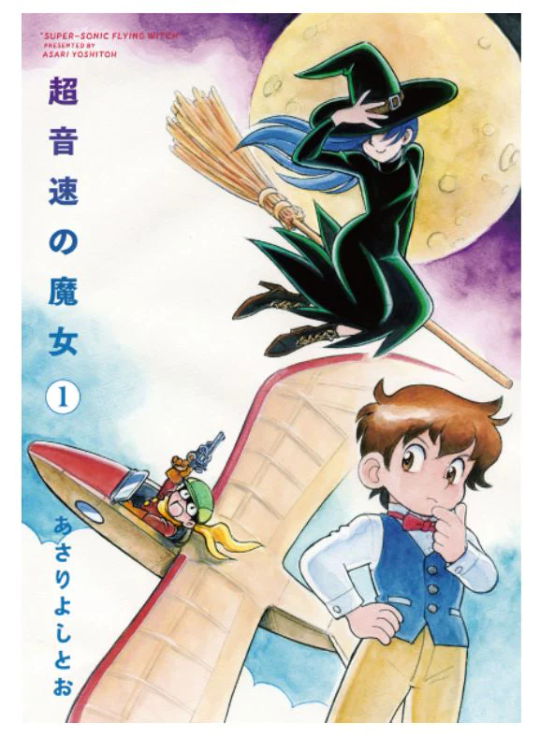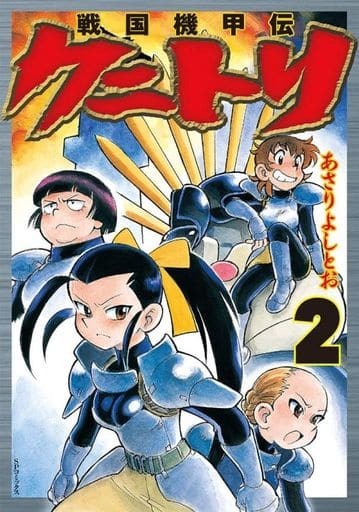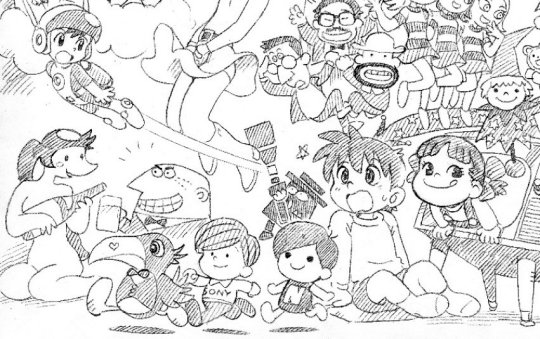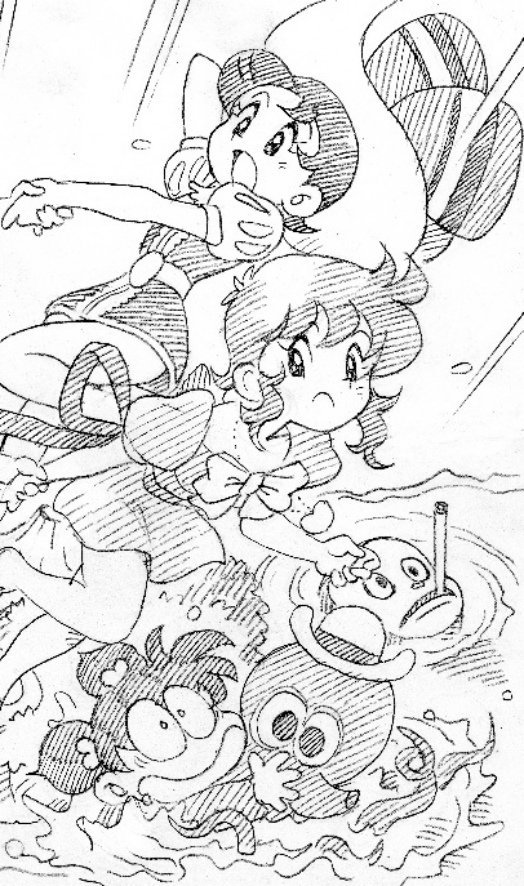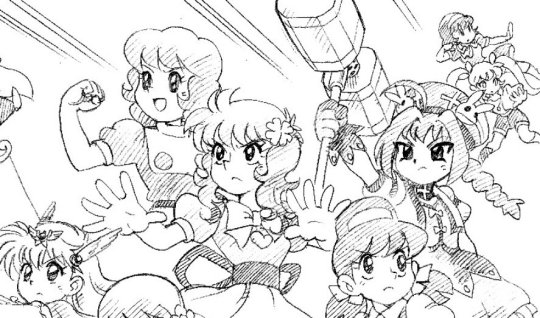#Yoshito Asari
Text
Chikyuu Bouei Shoujo Iko-chan
One of the interesting side effects of defining this blog's scope in the way that I have is that, for better or for worse, only focusing on magical girl manga that don't have anime adaptations automatically filters out almost every multimedia franchise. Sure we've talked about a couple manga adaptations of big live action productions, but there's a difference between that and a series that spreads itself across a handful of mediums simultaneously. Most magical girl multimedia projects from Japan will throw an anime of some form into the mix. Which is to say most, but not all. Today we'll be taking a look at a series which, throughout the late 80s and early 90s, released manga, a video game, a live action series, and more, but has no anime.
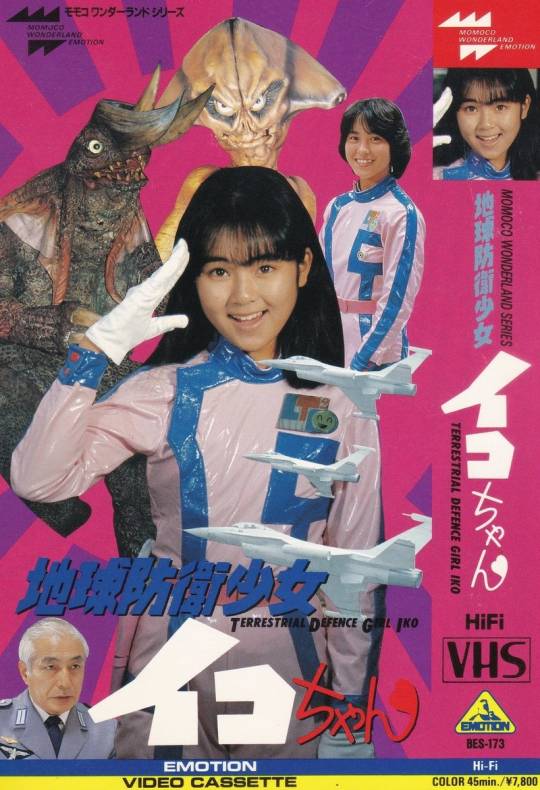
Chikyuu Bouei Shoujo Iko-chan (Terrestrial Defense Girl Iko) started as a live action direct-to-video series in 1987. The protagonist is Iko Kawai, a middle schooler who one day helps a member of the intergalactic police she sees lying unconscious on the pavement, and as a reward she is gifted a high tech headset called the Super Incom. The Super Incom allows her to use ESP to do what she believes is right, giving her abilities including but not limited to instant outfit changes, teleportation, leaping tall buildings in a single bound, shrinking, and communicating with beasts. In using her newfound powers, she catches the attention of an Earth defense squad known as the Light Terrestrial Defense Team, LTDT for short. They recruit Iko as a new member, and now armed with her Super Incom and gadgets from the LTDT, it is her duty to protect Earth from extraterrestrial threats.
The first entry in the series, an approximately 47 minute movie, was released on February 28, 1987. The monster designs were done by Toru Narita, who had done special effects work for Godzilla, and co-created Ultraman; so his involvement helped draw attention to the project. The series even has an Ultraman parody character in the form of Miracleman, who can grow to enormous size, but passes out when he does so.

A second movie was released on July 14, 1988, at the start of which Iko bequeaths her Super Incom to a new girl, coincidentally named Iko Sugekawa, who also goes on to work for the LTDT. While the original Iko was played by Akiko Isozaki, a relatively obscure child actress, the new Iko was played by Mia Masuda, a popular idol who was just getting her start around this time. This meant many Iko-chan fans were also Mia Masuda fans, and vice versa. Even now many people seem to know of the series predominantly through her involvement. This movie gives Iko a new (and more iconic) outfit, plus a spectacularly intelligent and accomplished rival named Runna Hakuba. Mia Masuda would stay on as Iko for the third movie, released on June 22, 1990, but each subsequent production would cast a different actress in the role. As for the series director, Minoru Kawasaki is known for producing tokusatsu parodies on the cheap, with Terrestrial Defense Girl Iko being one such example.

Due to the success of the original movie trilogy, a video game based on the series was released for the PC98 engine on December 4, 1992. Titled Chikyuu Bouei Shoujo Iko-chan ~UFO Daisakusen~ (Terrestrial Defense Girl Iko ~The Great UFO Strategy~, this is a turn-based battle game with visual novel elements, in which the LTDT face off against various aliens. Unfortunately, the game didn't sell well. It's speculated that the gameplay style didn't capture the appeal of the title's tokusatsu origins. The in-game art is very pretty though, for whatever that's worth.
Iko would continue starring in live action sequels and spinoffs after that, and a number of companion books were released for the series as well, but the release most relevant to this blog is the Iko-Chan manga.
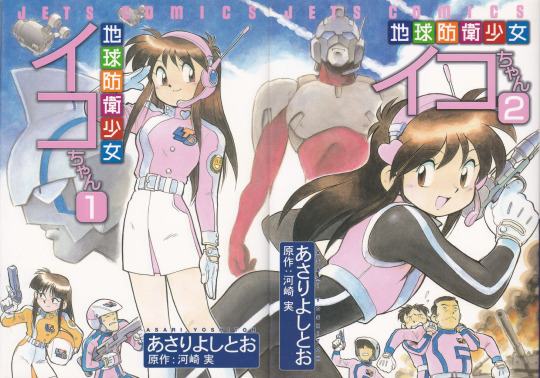
Running in monthly Comic Comp from the May 1988 issue to the May 1991 issue, this manga was created by Yoshito Asari, with writing input from Minoru Kawasaki, the original director. Asari is best known for his involvement in the production of the original Evangelion anime, for which he was an assistant character designer, and he penned a 4koma spinoff titled Evangelion Yonkoma Zenshuu. However, he is an accomplished mangaka in his own right, creating works such as Wahhaman, Manga Science, and Space Family Carlvinson, the lattermost of which would get an OVA adaptation in 1988.
Over the course of its' run, the Iko-chan manga would amass a total of 32 chapters. The first tankobon volume, containing chapters 1 through 18, was published by Kadokawa on September 13, 1990, but the remainder of the series would not be compiled until a new edition of both volumes was released by Hakusensha under their Jets Comics label on December 25, 1999. A digital rerelease, also by Hakusensha, was made available on December 26, 2014.
This manga makes some changes to the original plot, particularly in Iko's backstory. In this version, Iko already works for the LTDT part-time at the start of the series, and she gets the Super Incom after helping Miracleman while he's drunk. It's less momentous, but I actually prefer it given how poorly the original Iko's buddying up to cops has aged. The way the Super Incom works is slightly different too: it activates when she says please, enunciating each syllable (o-ne-ga-i). This makes whatever she thinks will help happen, but if she attempts to use this power for selfish reasons, the device will malfunction.
Unfortunately, I wasn't able to read very much of the manga, and the language barrier made it difficult to get into any version of this series. Huge shout-out to the surprisingly detailed Japanese Wikipedia page, which was a tremendous help in researching for this overview. They also have quite a bit of information on later installments in this series I glossed over. There is a lot more I could get into, but I wanted to mainly focus on the meat of the franchise, and this post is long enough as is.
I really hope fan translations of the series become available one day, because Terrestrial Defense Girl Iko seems like a lot of fun, and I would definitely recommend it to fans of older tokusatsu. There are elements of it I don't vibe with, but still, it has an interesting premise, some decently entertaining humor, a super catchy theme song, and a killer aesthetic.
#my posts#long post#Chikyuu Bouei Shoujo Iko-chan#Terrestrial Defense Girl Iko#Earth Defense Girl Iko-chan#地球防衛少女イコちゃん#Minoru Kawasaki#河崎実#Yoshito Asari#Yoshitoh Asari#Yoshitoo Asari#あさりよしとお#Monthly Comic Comp#shounen#80s#live action#video game
14 notes
·
View notes
Text

For my sixty-seventh Evangelion book review, here is Shin Seiki Evangelion Koushiki Guide Book (Neon Genesis Evangelion Official Guide Book), published by Kadokawa Shoten. This 171-page paperback is a guide to Yoshiyuki Sadamoto's Evangelion manga, however it was released before the manga was finished, so it only covers the first 12 volumes (the whole manga was 14 volumes).
This book is not available in English or French - although the chapter titles are in English - but it has plenty of pictures. The illustrations are in full color for the first twelve pages, and then the rest of the book is in black-and-white. (The book's dust jacket is also removable, however there is no alternate cover art hidden underneath.) The full color pages are devoted to the cover art for the first 12 volumes of the manga. For example, here is the cover for Volume 6, which features Toji, Hikari, and Evangelion Unit-03:
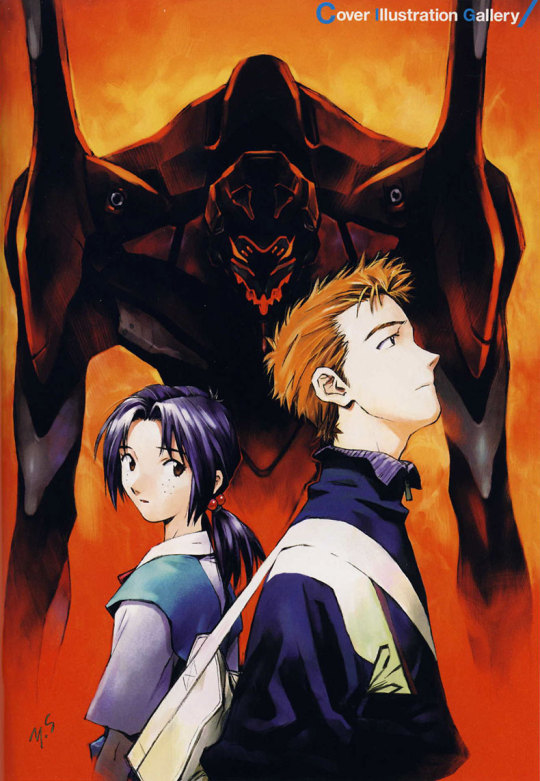
It's interesting how some of the characters' hair color in the manga is different from how they look in the anime. And as many of you probably already know, Shinji's eyes are a different color as well.
By the way, this is going to be another multiship-friendly review, so expect a mix of ReiShin, KawoShin, and AsuShin. Keep reading for the rest of the book review, plus a few more pictures!
After the Cover Illustration Gallery, there is a title page and a Table of Contents page, and then the first chapter of the book which is called "the Character". This section contains pics and information about various characters, including dates of birth and blood types, and discussions about the characters' personalities. Shinji, Rei, Asuka, Kaworu, and Misato each get 4 pages devoted to them, while the other characters only get one or two pages. The other characters in this chapter are Toji, Kensuke, Hikari, Gendo, Ritsuko, Kaji, Fuyutsuki, Maya and Makoto and Shigeru (these three characters are squeezed together into two pages), Yui, Naoko, and Keel. This part of the book also contains three brief columns about other topics: Evangelions and Angels, Nerv, and Seele.
By the way, even though this chapter has lots of pictures, they're all from the manga, so you won't see anything new here if you've already read the manga. Also, many of the pages have multiple images all crammed together, so the pics end up being very tiny. Most of the book is like this, unfortunately.
The second chapter of this book is called "the Episode", and it contains illustrated timelines for events in the manga (again, only for the first 12 volumes), plus information on battles, characters' relationships, and some background stuff about Nerv and Seele. The section on relationships isn't just about romance; it also covers family (for example, Asuka and her mother) and friendships (such as Shinji and his classmates). Anyway, I said this would be a multiship-friendly review, so I'll get to that now. Let's start with Rei and Shinji. This chapter devotes three pages to Rei's relationship with Shinji (two of those pages are for Rei II, while the third page is about the introduction of Rei III). Here is a piece from one of those pages:

Awww, Rei and Shinji holding hands! So sweet! (By the way, the above scan is larger than actual size, so you can see it better. As I mentioned before, a lot of the pictures in this book are really small.)
Moving on, this chapter has two pages about Kaworu's relationship with Shinji. Here's a piece from one of those pages (yes, the kiss is here):

Such an iconic moment. ^_^
As for Asuka and Shinji, um... This chapter only devotes half a page to their relationship. Yeah, not even one full page (the other half of the page is for Asuka and Kaji). What the heck? None of the illustrations for the Asuka and Shinji portion are romantic, either: There's a picture of Shinji, Toji, and Kensuke freaking out; a pic of Asuka kicking somebody; and a picture of Misato standing next to Asuka. That's it. Fortunately, there are some images later in the book that I think AsuShin fans will like, so don't worry, I'll get to those next!
The third chapter of the book is "All of Yoshiyuki Sadamoto". It starts with a Q&A section, and then there's a gallery of the title page illustrations from various chapters of the manga. Like many other parts of the book, this gallery crams multiple images onto each page, so most of the pics are tiny. But at any rate, here are some cute ones that AsuShin fans can enjoy:

Adorable pics, aren't they? The one of Shinji and Asuka dancing together is so precious!
The next part of this chapter has some pictures and info about other manga that Sadamoto has worked on, plus his art books, and other things for which he has done illustrations or character designs such as album covers, video games, and anime. There is also a timeline of his career, and some extra comments from him.
Okay, next we have the fourth chapter of the book, which is called "Message from EVA Friends". It starts with a conversation between Hiroya Oku (creator of the manga Gantz) and Yoshiyuki Sadamoto. After that, there are short messages from some of the Evangelion anime staff: Hideaki Anno (creator), Ikuto Yamashita (mecha designer), Yoshito Asari (assistant character designer), Yuko Miyamura (voice of Asuka), and Megumi Hayashibara (voice of Rei).
The next part of the chapter has illustrated messages from various writers/artists. Finally, some pictures that aren't already in the graphic novels! Check out this message from Kazuya Tsurumaki (assistant director for the Evangelion TV series, director for the first half of The End of Evangelion, and one of the directors for the New Theatrical Edition - AKA "Rebuild" - movies):

What a cute drawing of Asuka!
All right, I'll show one more illustrated message from this section. This is from Jinsei Kataoka and Kazuma Kondou (the writer and the artist for the manga Deadman Wonderland):

Wow, Rei and Evangelion Unit-01 look pretty cool in that art style!
The book's fifth chapter is "Comic EVA History", and it shows Evangelion-related covers for various issues of Monthly Shounen Ace magazine and Young Ace magazine (the chapters of Sadamoto's Evangelion manga were originally published in Monthly Shounen Ace, and then starting in the summer of 2009 the remaining chapters were published in Young Ace). This part of the book also has pictures of some Evangelion-related bonus goodies that could be obtained with those magazines, such as posters, cards, and stickers.
And finally, the sixth chapter of the book is called "Extra Part", which includes notes for some of the terminology used in the manga, such as "LCL" and "entry plug". Then the book ends with a short psychology test to see which of the Children you are most in sync with.
Overall, I don't really recommend Shin Seiki Evangelion Koushiki Guide Book. It's supposed to be a guide to Sadamoto's Evangelion manga, but it was released before the last two volumes of the manga came out, so the information is not complete. Also, most of the illustrations are smaller versions of images that you can already see by simply reading the manga, so it isn't even all that great as an art book. It just feels like a cash grab. There are much better Evangelion books out there, so I would say don't bother with this one unless you're a serious collector who wants to obtain as many Evangelion-related publications as possible. Anyway, that's just my opinion. Your mileage may vary.
Well, that’s it for my sixty-seventh Evangelion book review. I have plenty more Evangelion books to discuss, so keep checking my blog for new reviews!
#Evangelion#KawoShin#ReiShin#AsuShin#Kaworu Nagisa#Rei Ayanami#Asuka Langley Soryu#Shinji Ikari#Toji Suzuhara#Hikari Horaki#Evangelion Unit 01#Evangelion Unit 03#book review
183 notes
·
View notes
Photo

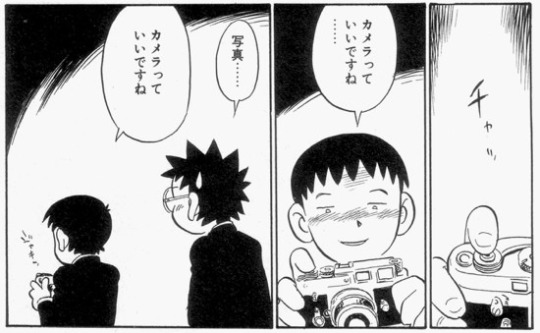
Yoshito Asari "Ruku Ruku"
あさりよしとお「るくるく」
141 notes
·
View notes
